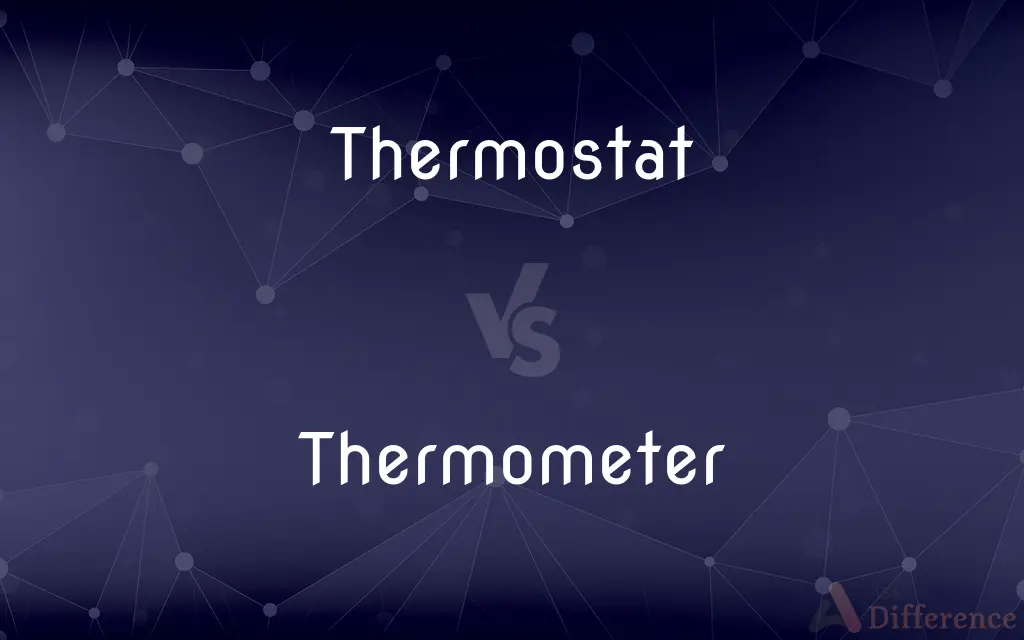Thermostat vs. Thermometer — What's the Difference?
By Tayyaba Rehman & Urooj Arif — Updated on February 28, 2024
A thermostat controls temperature by turning heating or cooling systems on or off, while a thermometer measures and displays the temperature.

Difference Between Thermostat and Thermometer
Table of Contents
ADVERTISEMENT
Key Differences
Thermostats are devices used to regulate the temperature of a space by activating heating or cooling systems based on user settings. Thermometers, in contrast, are instruments designed to measure and indicate the current temperature of an environment or object without influencing it.
A thermostat works by setting a desired temperature and maintaining that level by controlling heating or cooling systems. A thermometer simply reads the temperature, providing data that can be used for various purposes, including informing decisions on thermostat settings.
Thermostats can be programmable, allowing users to set different temperatures for different times of the day or week, optimizing comfort and energy efficiency. Thermometers might have features like digital displays or remote sensing, but they do not control environmental systems.
In addition to their primary functions, thermostats may include features like Wi-Fi connectivity, allowing remote control and monitoring of home temperatures. Thermometers often focus on precision and reliability in temperature measurement, with some models designed for specific applications, such as cooking or outdoor weather monitoring.
Thermostats are integral to heating, ventilation, and air conditioning (HVAC) systems in buildings, thermometers are used in a wider range of fields, including medicine, scientific research, and food safety, reflecting their broader application beyond temperature regulation.
ADVERTISEMENT
Comparison Chart
Primary Function
Regulates temperature by controlling HVAC systems
Measures and displays temperature
User Interaction
Users set desired temperatures
Users read temperature measurements
Additional Features
Programmable settings, Wi-Fi connectivity
Digital displays, specific applications (medical, cooking)
Application
Used in buildings for comfort and energy efficiency
Used in various fields (medicine, research, cooking)
Influence on Environment
Actively alters the environment to maintain set temperature
Passively observes the environment without altering it
Compare with Definitions
Thermostat
A device that regulates the temperature of a system.
The thermostat turns the heat on when the room gets too cold.
Thermometer
Can be mercury, digital, or infrared.
Digital thermometers give a quick and accurate reading.
Thermostat
Programmable to optimize energy use.
We set the thermostat to lower the temperature at night.
Thermometer
Used in various applications.
A meat thermometer ensures the chicken is cooked safely.
Thermostat
Can be mechanical or digital.
Our new digital thermostat can be controlled with a smartphone.
Thermometer
May feature remote reading.
The outdoor thermometer transmits the temperature to a display inside.
Thermostat
Integral to HVAC systems.
The thermostat malfunction caused the air conditioning to run constantly.
Thermometer
An instrument for measuring temperature.
We used a thermometer to check if the fever had gone down.
Thermostat
Often includes remote sensing.
The thermostat's remote sensor helps balance the temperature throughout the house.
Thermometer
Essential for scientific research.
Researchers used a thermometer to monitor the reaction temperature.
Thermostat
A thermostat is a regulating device component which senses the temperature of a physical system and performs actions so that the system's temperature is maintained near a desired setpoint. Thermostats are used in any device or system that heats or cools to a setpoint temperature, examples include building heating, central heating, air conditioners, HVAC systems, water heaters, as well as kitchen equipment including ovens and refrigerators and medical and scientific incubators.
Thermometer
A thermometer is a device that measures temperature or a temperature gradient (the degree of hotness or coldness of an object). A thermometer has two important elements: (1) a temperature sensor (e.g.
Thermostat
A device that automatically regulates temperature, or that activates a device when the temperature reaches a certain point.
Thermometer
An instrument for measuring temperature, especially one having a graduated glass tube with a bulb containing a liquid, typically mercury or colored alcohol, that expands and rises in the tube as the temperature increases.
Thermostat
A device, as in a home heating system, a refrigerator, or an air conditioner, that automatically responds to temperature changes and activates switches controlling the equipment.
Thermometer
An apparatus used to measure temperature.
Thermostat
A device that automatically responds to changes in temperature by activating a heating or cooling system to maintain the temperature at a desired setting.
Thermometer
An instrument for measuring temperature, founded on the principle that changes of temperature in bodies are accompanied by proportional changes in their volumes or dimensions.
Thermostat
(physics) An algorithm used to maintain a simulated system at a set temperature by absorbing or releasing heat
Thermometer
Measuring instrument for measuring temperature
Thermostat
A regulator for automatically regulating temperature by starting or stopping the supply of heat
Thermostat
Control the temperature with a thermostat
Common Curiosities
Are digital thermometers more accurate than mercury ones?
Digital thermometers offer quick readings and are considered safe and accurate, but mercury thermometers are known for their precision.
Do all thermostats have Wi-Fi connectivity?
No, Wi-Fi connectivity is a feature of smart thermostats, not all thermostats.
What's the main difference between a thermostat and a thermometer?
A thermostat controls temperature, while a thermometer measures and displays it.
Why is it important to have a thermometer in medical settings?
It's crucial for monitoring patients' body temperatures, which can indicate health conditions.
Can smart thermostats be controlled remotely?
Yes, smart thermostats can be controlled via smartphones or computers.
Are there thermometers for specific environmental conditions?
Yes, there are thermometers specially designed for extreme temperatures, humidity levels, and other specific conditions.
Can a thermostat work without a thermometer?
No, thermostats need a thermometer component to measure temperature for control purposes.
Can I use a thermometer to control room temperature?
A thermometer can only inform you of the temperature; controlling it requires a thermostat.
Is a thermostat necessary in every home?
While not strictly necessary, a thermostat is essential for maintaining comfortable temperatures efficiently.
What are the benefits of a digital thermometer over a traditional one?
Digital thermometers provide faster readings and eliminate the risk of mercury exposure.
What type of thermometer is used for cooking?
Food or meat thermometers are used to ensure food is cooked to safe temperatures.
How do outdoor thermometers differ from indoor ones?
Outdoor thermometers are designed to withstand weather conditions, while indoor ones are for room temperature monitoring.
What should I consider when buying a thermostat or thermometer?
Consider the specific needs, such as the level of control or precision required, and whether smart features are desired.
How does a programmable thermostat save energy?
By allowing users to set lower temperatures when not home or asleep, reducing unnecessary heating or cooling.
How often should a thermostat be replaced?
It depends on the model, but generally, thermostats can last 10 years or more with proper maintenance.
Share Your Discovery

Previous Comparison
Appendices vs. Annex
Next Comparison
Fail vs. FlunkAuthor Spotlight
Written by
Tayyaba RehmanTayyaba Rehman is a distinguished writer, currently serving as a primary contributor to askdifference.com. As a researcher in semantics and etymology, Tayyaba's passion for the complexity of languages and their distinctions has found a perfect home on the platform. Tayyaba delves into the intricacies of language, distinguishing between commonly confused words and phrases, thereby providing clarity for readers worldwide.
Co-written by
Urooj ArifUrooj is a skilled content writer at Ask Difference, known for her exceptional ability to simplify complex topics into engaging and informative content. With a passion for research and a flair for clear, concise writing, she consistently delivers articles that resonate with our diverse audience.















































